In the interest of better learning Qt, I would like to learn how it would be possible to use the C++ header file output of Qt's User Interface Compiler to programmatically recreate the same UI design (e.g. as the one derived by using the Designer in Qt Creator).
Should I create a new header file in my Qt project and copy the contents of that uic output? Which parts from the uic ouptut go where and how should I call them in the .cpp?
Is this best approach in terms of good programming practices; not interested in opinions, only on how to properly separate definitions and use the header and source files as they are meant to?
A minimal example of where/how to define the layouts and widgets and how to invoke/customise them (perhaps in the .cpp file?) would be a great learning tool for me.
As an example, here is an example of a GUI design created with the Qt Creator's Designer tool with several nested layouts and multiple widgets:
And this is the header file ouptut from the uic for the above GUI design:
#ifndef UI_MAINWINDOW_H
#define UI_MAINWINDOW_H
#include <QtCore/QVariant>
#include <QtWidgets/QAction>
#include <QtWidgets/QApplication>
#include <QtWidgets/QButtonGroup>
#include <QtWidgets/QFormLayout>
#include <QtWidgets/QFrame>
#include <QtWidgets/QGridLayout>
#include <QtWidgets/QHBoxLayout>
#include <QtWidgets/QHeaderView>
#include <QtWidgets/QLabel>
#include <QtWidgets/QLineEdit>
#include <QtWidgets/QMainWindow>
#include <QtWidgets/QProgressBar>
#include <QtWidgets/QPushButton>
#include <QtWidgets/QSpacerItem>
#include <QtWidgets/QVBoxLayout>
#include <QtWidgets/QWidget>
QT_BEGIN_NAMESPACE
class Ui_MainWindow
{
public:
QWidget *centralWidget;
QVBoxLayout *verticalLayout_3;
QFrame *top_frame;
QGridLayout *gridLayout;
QSpacerItem *horizontalSpacer;
QProgressBar *progressBar_2;
QProgressBar *progressBar_4;
QSpacerItem *verticalSpacer;
QSpacerItem *horizontalSpacer_2;
QPushButton *pushButton_1;
QProgressBar *progressBar_1;
QPushButton *pushButton_2;
QPushButton *pushButton_3;
QProgressBar *progressBar_3;
QPushButton *pushButton_4;
QFrame *bottom_frame;
QHBoxLayout *horizontalLayout;
QFrame *frame;
QFormLayout *formLayout;
QLabel *label_1;
QLabel *label_2;
QSpacerItem *verticalSpacer_2;
QLineEdit *lineEdit;
QLineEdit *lineEdit_2;
QFrame *frame_2;
QHBoxLayout *horizontalLayout_2;
QLabel *label_3;
QSpacerItem *horizontalSpacer_3;
QLabel *label_4;
void setupUi(QMainWindow *MainWindow)
{
if (MainWindow->objectName().isEmpty())
MainWindow->setObjectName(QStringLiteral("MainWindow"));
MainWindow->resize(878, 632);
centralWidget = new QWidget(MainWindow);
centralWidget->setObjectName(QStringLiteral("centralWidget"));
verticalLayout_3 = new QVBoxLayout(centralWidget);
verticalLayout_3->setSpacing(6);
verticalLayout_3->setContentsMargins(11, 11, 11, 11);
verticalLayout_3->setObjectName(QStringLiteral("verticalLayout_3"));
top_frame = new QFrame(centralWidget);
top_frame->setObjectName(QStringLiteral("top_frame"));
QSizePolicy sizePolicy(QSizePolicy::Preferred, QSizePolicy::Expanding);
sizePolicy.setHorizontalStretch(0);
sizePolicy.setVerticalStretch(0);
sizePolicy.setHeightForWidth(top_frame->sizePolicy().hasHeightForWidth());
top_frame->setSizePolicy(sizePolicy);
top_frame->setFrameShape(QFrame::StyledPanel);
top_frame->setFrameShadow(QFrame::Raised);
gridLayout = new QGridLayout(top_frame);
gridLayout->setSpacing(6);
gridLayout->setContentsMargins(11, 11, 11, 11);
gridLayout->setObjectName(QStringLiteral("gridLayout"));
horizontalSpacer = new QSpacerItem(30, 20, QSizePolicy::Fixed, QSizePolicy::Minimum);
gridLayout->addItem(horizontalSpacer, 0, 2, 1, 1);
progressBar_2 = new QProgressBar(top_frame);
progressBar_2->setObjectName(QStringLiteral("progressBar_2"));
progressBar_2->setValue(24);
gridLayout->addWidget(progressBar_2, 2, 3, 1, 1);
progressBar_4 = new QProgressBar(top_frame);
progressBar_4->setObjectName(QStringLiteral("progressBar_4"));
progressBar_4->setValue(24);
gridLayout->addWidget(progressBar_4, 2, 5, 1, 1);
verticalSpacer = new QSpacerItem(20, 10, QSizePolicy::Minimum, QSizePolicy::Fixed);
gridLayout->addItem(verticalSpacer, 1, 1, 1, 1);
horizontalSpacer_2 = new QSpacerItem(10, 20, QSizePolicy::Fixed, QSizePolicy::Minimum);
gridLayout->addItem(horizontalSpacer_2, 0, 4, 1, 1);
pushButton_1 = new QPushButton(top_frame);
pushButton_1->setObjectName(QStringLiteral("pushButton_1"));
gridLayout->addWidget(pushButton_1, 0, 0, 1, 1);
progressBar_1 = new QProgressBar(top_frame);
progressBar_1->setObjectName(QStringLiteral("progressBar_1"));
progressBar_1->setValue(24);
gridLayout->addWidget(progressBar_1, 0, 3, 1, 1);
pushButton_2 = new QPushButton(top_frame);
pushButton_2->setObjectName(QStringLiteral("pushButton_2"));
gridLayout->addWidget(pushButton_2, 0, 1, 1, 1);
pushButton_3 = new QPushButton(top_frame);
pushButton_3->setObjectName(QStringLiteral("pushButton_3"));
gridLayout->addWidget(pushButton_3, 2, 0, 1, 1);
progressBar_3 = new QProgressBar(top_frame);
progressBar_3->setObjectName(QStringLiteral("progressBar_3"));
progressBar_3->setValue(24);
gridLayout->addWidget(progressBar_3, 0, 5, 1, 1);
pushButton_4 = new QPushButton(top_frame);
pushButton_4->setObjectName(QStringLiteral("pushButton_4"));
gridLayout->addWidget(pushButton_4, 2, 1, 1, 1);
verticalLayout_3->addWidget(top_frame);
bottom_frame = new QFrame(centralWidget);
bottom_frame->setObjectName(QStringLiteral("bottom_frame"));
bottom_frame->setFrameShape(QFrame::StyledPanel);
bottom_frame->setFrameShadow(QFrame::Raised);
horizontalLayout = new QHBoxLayout(bottom_frame);
horizontalLayout->setSpacing(6);
horizontalLayout->setContentsMargins(11, 11, 11, 11);
horizontalLayout->setObjectName(QStringLiteral("horizontalLayout"));
frame = new QFrame(bottom_frame);
frame->setObjectName(QStringLiteral("frame"));
frame->setFrameShape(QFrame::StyledPanel);
frame->setFrameShadow(QFrame::Raised);
formLayout = new QFormLayout(frame);
formLayout->setSpacing(6);
formLayout->setContentsMargins(11, 11, 11, 11);
formLayout->setObjectName(QStringLiteral("formLayout"));
label_1 = new QLabel(frame);
label_1->setObjectName(QStringLiteral("label_1"));
formLayout->setWidget(0, QFormLayout::LabelRole, label_1);
label_2 = new QLabel(frame);
label_2->setObjectName(QStringLiteral("label_2"));
formLayout->setWidget(1, QFormLayout::LabelRole, label_2);
verticalSpacer_2 = new QSpacerItem(20, 20, QSizePolicy::Minimum, QSizePolicy::Expanding);
formLayout->setItem(2, QFormLayout::LabelRole, verticalSpacer_2);
lineEdit = new QLineEdit(frame);
lineEdit->setObjectName(QStringLiteral("lineEdit"));
QSizePolicy sizePolicy1(QSizePolicy::Expanding, QSizePolicy::Expanding);
sizePolicy1.setHorizontalStretch(0);
sizePolicy1.setVerticalStretch(0);
sizePolicy1.setHeightForWidth(lineEdit->sizePolicy().hasHeightForWidth());
lineEdit->setSizePolicy(sizePolicy1);
formLayout->setWidget(3, QFormLayout::SpanningRole, lineEdit);
lineEdit_2 = new QLineEdit(frame);
lineEdit_2->setObjectName(QStringLiteral("lineEdit_2"));
sizePolicy1.setHeightForWidth(lineEdit_2->sizePolicy().hasHeightForWidth());
lineEdit_2->setSizePolicy(sizePolicy1);
formLayout->setWidget(4, QFormLayout::LabelRole, lineEdit_2);
horizontalLayout->addWidget(frame);
frame_2 = new QFrame(bottom_frame);
frame_2->setObjectName(QStringLiteral("frame_2"));
frame_2->setFrameShape(QFrame::StyledPanel);
frame_2->setFrameShadow(QFrame::Raised);
horizontalLayout_2 = new QHBoxLayout(frame_2);
horizontalLayout_2->setSpacing(6);
horizontalLayout_2->setContentsMargins(11, 11, 11, 11);
horizontalLayout_2->setObjectName(QStringLiteral("horizontalLayout_2"));
label_3 = new QLabel(frame_2);
label_3->setObjectName(QStringLiteral("label_3"));
horizontalLayout_2->addWidget(label_3);
horizontalSpacer_3 = new QSpacerItem(40, 20, QSizePolicy::Fixed, QSizePolicy::Minimum);
horizontalLayout_2->addItem(horizontalSpacer_3);
label_4 = new QLabel(frame_2);
label_4->setObjectName(QStringLiteral("label_4"));
horizontalLayout_2->addWidget(label_4);
frame->raise();
frame->raise();
label_3->raise();
label_4->raise();
horizontalLayout->addWidget(frame_2);
verticalLayout_3->addWidget(bottom_frame);
MainWindow->setCentralWidget(centralWidget);
retranslateUi(MainWindow);
QMetaObject::connectSlotsByName(MainWindow);
} // setupUi
void retranslateUi(QMainWindow *MainWindow)
{
MainWindow->setWindowTitle(QApplication::translate("MainWindow", "MainWindow", 0));
pushButton_1->setText(QApplication::translate("MainWindow", "PushButton_1", 0));
pushButton_2->setText(QApplication::translate("MainWindow", "PushButton_2", 0));
pushButton_3->setText(QApplication::translate("MainWindow", "PushButton_3", 0));
pushButton_4->setText(QApplication::translate("MainWindow", "PushButton_4", 0));
label_1->setText(QApplication::translate("MainWindow", "TextLabel_1", 0));
label_2->setText(QApplication::translate("MainWindow", "TextLabel_2", 0));
label_3->setText(QApplication::translate("MainWindow", "TextLabel_3", 0));
label_4->setText(QApplication::translate("MainWindow", "TextLabel_4", 0));
} // retranslateUi
};
namespace Ui {
class MainWindow: public Ui_MainWindow {};
} // namespace Ui
QT_END_NAMESPACE
#endif // UI_MAINWINDOW_H
(this question is -basically- a follow-up from my previous question)


